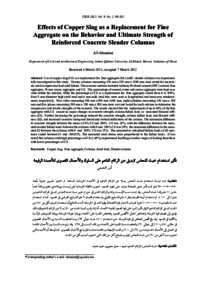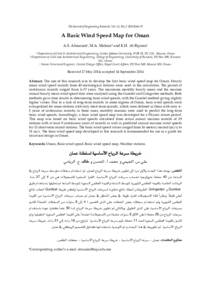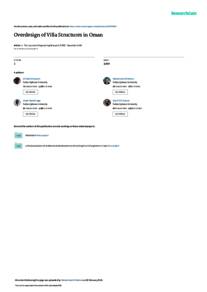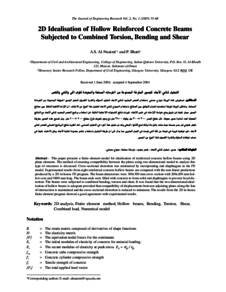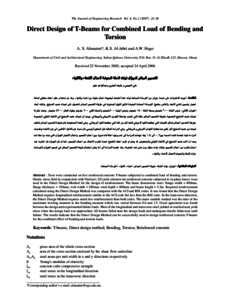Document
Effects of copper slag as a replacement for fine aggregate on the behavior and ultimate strength of reinforced concrete slender columns.
Publisher
Sultan Qaboos University
Gregorian
2012
Language
English
English abstract
Use of copper slag (CS) as a replacement for fine aggregate (FA) in RC slender columns was experimentally investigated in this study. Twenty columns measuring 150 mm x150 mm x 2500 mm were tested for monotonic axial compression load until failure. The concrete mixture included ordinary Portland cement (OPC) cement, fine aggregate, 10 mm coarse aggregate, and CS. The cpercentage of cement, water and coarse aggregate were kept constant within the mixture, while the percentage of CS as a replacement for fine aggregate varied from 0 to 100%. Four 8 mm diameter high yield steel and 6 mm mild steel bars were used as longitudinal and transverse reinforcement, respectively. Five cubes measuring 100 mm x100 mm x100 mm, eight cylinders measuring 150 mm x 300 mm and five prisms measuring 100 mm x 100 mm x 500 mm were cast and tested for each mixture to determine the compressive and tensile strengths of the concrete. The results showed that the replacement of up to 40% of the fine aggregate with CS caused no major changes in concrete strength, column failure load, or measured flexural stiffness (EI). Further increasing the percentage reduced the concrete strength, column failure load, and flexural stiffness (EI), and increased concrete slump and lateral and vertical deflections of the column. The maximum difference in concrete strength between the mixes of 0% CS and 100% CS was 29%, with the difference between the measured/ control failure loads between the columns with 0 and 100% CS was 20% the maximum difference in the measured EI between the columns with 0 and 100% CS was 25%. The measured to calculated failure loads of all specimen varied between 91 and -100.02%. The measured steel strains were proportional to the failure loads. It was noted that columns with high percentages of CS (≥ 60%) experienced buckling at earlier stages of loading than those with lower percentages of CS.
Member of
ISSN
1726-6742
Resource URL
Citation
Al-Nuaimi, A. S. (2012). Effects of copper slag as a replacement for fine aggregate on the behavior and ultimate strength of reinforced concrete slender columns. The Journal of Engineering Research, 9 (2), 90-102.
Arabic abstract
تمت دراسة استخدام خبث النحاس بديلا عن الركام الناعم في الأعمدة الخرسانية المسلحة. تم اختيار عشرين عمود بأبعاد 150 × 150 × 2500 ملم تحت تأثير حمل انضغاط متزايد حتى انهيار العمود. احتوت الخلطة الخرسانية على إسمنت بورتلاندي عادي وركاما ناعما خشن 10 ملم زائدا خبث النحاس. وقد ثبتت نسب الإسمنت والماء والركام الخشن في حين تم تغيير نسبة خبث النحاس كبديل للركام الناعم من صفر إلى 100 %. تم استخدام أربعة قضبان بقطر 8 ملم للتسليح الطولي واستخدام قضبان 6 ملم للتسليح العرضي في العمود. كما تم استخدام خمسة مكعبات (100 × 100 × 100 ملم) كعينات لاختبار قوة الانضغاط وقوة الشد في الخرسانة. أثبتت النتائج أن استخدام كميات أقل من 40% من الخبث كبديل للركام الناعم لا يؤثر تأثيرا كبيرا على قوة العمود المقاومة الانحناء. أما إذا زادت كمية الخبث عن 40% بدلا عن الركام الناعم فإن ذلك يؤدي إلى نقصان قوة الخرسانة وانخفاض الحمل الأقصى للعمود وانخفاض القدرة على الانحناء وزيادة هبوط الخرسانة، وزيادة التشوهات الرأسية والأفقية في العمود. وقد بلغ أقصى انخفاض في قوة الخرسانة حين استخدام 100% خبث حوالي 29% بينما انخفضت النسبة بين الأحمال القصوى في حالتي 50% و 100% إلى حوالي 20% وانخفضت نسبة القدرة على الانحناء بين تلك النسب إلى 25%. وقد تراوحت النسبة بين الأحمال المقاسة في المعمل إلى الأحمال الحسابية ما بين 91% إلى 100% وكانت الإجهادات المقاسة متناسبة طرديا مع الأحمال القصوى. كما لوحظ أن الأعمدة التي احتوت نسبا أعلى من 60% من خبث النحاس انهارت بانبعاج أكثر من تلك التي احتوت كميات أقل من الخبث.
Category
Journal articles

